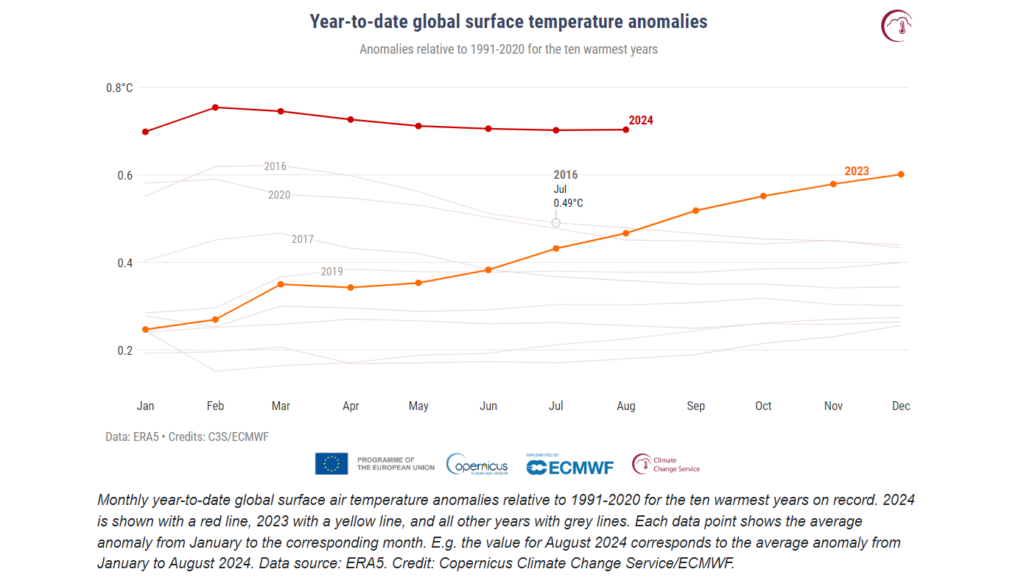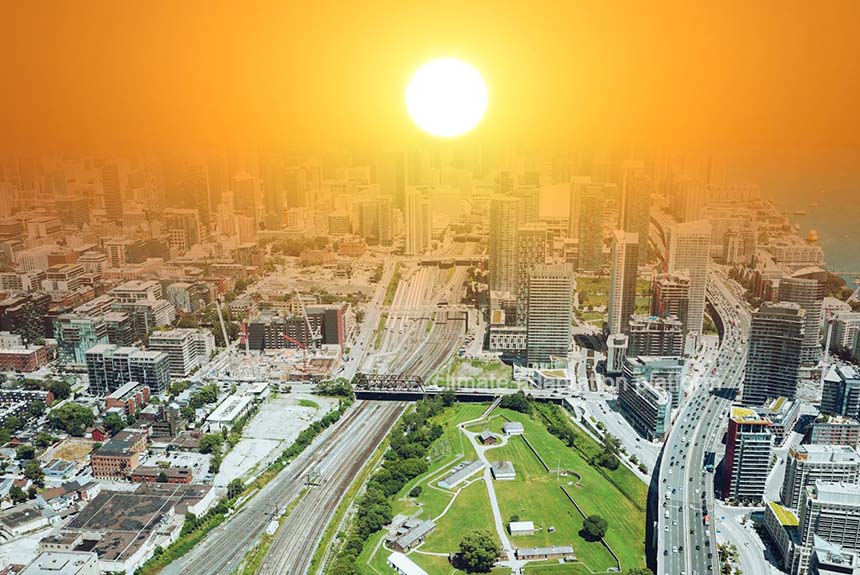New data from the Copernicus Climate Change Service (CS3) reveals that the summer of 2024 was the hottest on record globally.
In 2024, the world has seen the hottest June and August, the hottest day ever recorded, and the hottest boreal summer on record. These unprecedented temperatures make it highly likely that 2024 will be the hottest year on record.
According to Samantha Burgess, Deputy Director of the Copernicus Climate Change Service (C3S), the extreme temperature events witnessed this summer will continue to worsen unless urgent action is taken to reduce greenhouse gas emissions (Copernicus: Summer 2024, 2024).
Copernicus data of the surface air temperature anomalies of 2023 and 2024 below shows that August 2023 and August 2024 temperatures are tied at 1.51°C above the pre-industrial level, and both periods have surface air temperatures of 16.82°C, 0.71°C above the 1991-2020 average for August.

August 2024 also marks the 13th consecutive month where average temperatures were 1.51°C above the pre-industrial level. Each month between September 2023 and August 2024 also has the highest monthly average temperatures in any 12-month period since records began, with temperatures 0.76°C above the 1991–2020 average and 1.64°C above the 1850–1900 pre-industrial average.
Europe’s average temperature in August 2024 was 1.57°C above the 1991-2020 average, making it the second warmest August for the continent after August 2022, which was 1.73°C above average. Southern and eastern Europe see above-average but below-average temperatures over northwestern parts of Ireland and the United Kingdom, Iceland, the west coast of Portugal, and southern Norway.
Other parts of the world also had above-average temperatures in August, such as eastern Antarctica, Texas, Mexico, Canada, northeast Africa, Iran, China, Japan, and Australia.
Impacts of high temperatures around the world
Daily Mail presents how the extreme heat affected many parts of the world:
- Starting in the spring of 2024, Mexico and Central America suffered weeks of persistent heat, which, combined with a prolonged drought, led to severe water shortages and dozens of deaths.
- In Saudi Arabia, more than 1000 people died because of extreme heat during the Hajj, a Muslim pilgrimage to Mecca where temperatures reached 51.8°C at the Grand Mosque in Mecca on 17 June.
- Karachi, Pakistan, high heat, frequent power outages, and water shortages in some areas have overwhelmed their hospitals.
- India had temperatures of 48.9°C for several days in April and May, affecting millions of people, many without air conditioning.
- ‘Japan issued heatstroke alerts in Tokyo and more than half of its prefectures as temperatures rose to record highs in early July.
- ‘Large parts of Europe suffered a long-running heat wave as the 2024 Summer Olympics prepared to open in Paris in late July.’
LA Times reports that the summer season “was marked by explosive wildfires, sizzling heat waves and heat-related deaths in California and many other parts of the world” (Smith, 2024).
While rising temperatures are consistent with climate projects, the heat in 2024 has lasted longer than many expected, with temperatures like the latter half of 2023, says Zeke Hausfather, a climate scientist with Berkeley Earth (Smith, 2024).
He adds that although El Niño, a climate pattern associated with warmer global temperatures, dissipated toward the end of May, this did not lead to drops in global temperatures. This means that hot conditions remained steady without El Niño, implying additional factors are at work (Smith, 2024).
It is also worth noting that temperatures have exceeded the Paris Agreement temperature limit of 1.5°C, which was established to prevent the worst effects of climate change from 2023 until 2024.
Overshooting the 1.5°C temperature limit agreement
For years, policymakers and environmental groups have focused on limiting global warming to 1.5°C to prevent its worst effects. Still, Earth reached a bleak milestone this year when August became the 13th month that average temperatures exceeded the Paris Agreement temperature threshold of 1.5°C. So, have we breached the limit?
Climate Analytics says no because climate change is a human-made temperature change averaged over 20-30 years and not a variability from year to year (Schleussner et al., 2023).
Greening schoolyards in New York to combat heat
New York is greening the city, starting in its schoolyards. The city is nicknamed the “concrete jungle,” and it is overheating due to the urban heat island (UHI), which is worsened by climate change impacts. The city is begging for cool, shaded green spaces where locals of all ages can enjoy and find relief from the heat.
The city has 220 public schools, and thanks to the Trust for Public Land’s (TPL’s) Green Community Schoolyards programme, the asphalt playgrounds of these schools will be transformed into parks and green spaces, starting from one school to the next. TPL envisions that beyond being creational and community-building opportunities, these transformed green spaces will help mitigate the increasingly extreme heat and flooding impacting New York City.
The WRI article notes that New York City is over 70% waterproof, which means the city has paved most of its land and prevented stormwater from soaking into the ground. Without enough soil and natural terrain to absorb water quickly, cities are at higher risk of flooding during extreme rain events.
(TPL’s) Green Community Schoolyards transformations of empty asphalt lots into vibrant, green community spaces is simple, easy to replicate and scaled, and 15 other US cities are also following New York’s city’s lead, including Philadelphia, Tacoma, Wash. and Oakland, Calif., with differing urban forms and densities, governance structures and climates, including desert climates, the articles say.
This initiative also seeks to increase New York City’s low public playground ratio, currently at 2.2 per 10,000 residents, to the country’s average of 3.1 playgrounds in America’s 100 largest cities. Making green spaces more accessible to urban dwellers provides them with the climate, environmental, social, and economic benefits they offer.
Sources:
Copernicus: Summer 2024 – Hottest on record globally and for Europe. (2024, 6 September). Copernicus. Retrieved from https://climate.copernicus.eu/copernicus-summer-2024-hottest-record-globally-and-europe
Summer 2024 was the hottest on RECORD: Average global temperature was 0.69°C above average – and scientists say climate change is to blame. (2024, 6 September). Daily Mail. Retrieved from https://www.dailymail.co.uk/sciencetech/article-13817371/Summer-2024-hottest-RECORD-climate-change.html
Smith, H. (2024, 6 September). As California swelters, climate officials declare Summer 2024 the hottest on record. LA Times. Retrieved from https://www.latimes.com/environment/story/2024-09-06/summer-2024-was-earths-hottest-on-record
Bergen, M. (2024, 18 July). 1.5 Degrees of Global Warming—Are We There Yet? NRDC. Retrieved from https://www.nrdc.org/stories/15-degrees-global-warming-are-we-there-yet
Schleussner, C., Nauels, A., Klönne, U., & Hare, B. (2023, January 13). Is the 1.5°C limit still in reach? FAQs. Retrieved from https://climateanalytics.org/comment/is-the-15c-limit-still-in-reach-faqs
Shin, J. & Kustar, A. (2024, September 3). A Community Program Is Transforming New York Schoolyards into Climate-Resilient Spaces. WRI. Retrieved from https://www.wri.org/insights/new-york-city-climate-resilient-schoolyards?



Leave a Reply